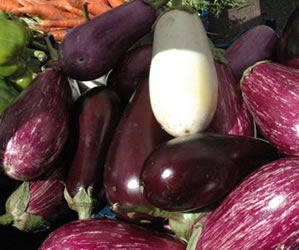There are many varieties of eggplant, ranging in color from rich purple to white, in length from 2 to 12 inches, and in shape from oblong to round.
In the United States, the most common eggplant is large and pear-shaped with a smooth, glossy, dark purple skin.
Then there's the very narrow, straight Japanese or Oriental eggplant, which ranges in color from violet to striated shades and has a tender, slightly sweet flesh.
The Italian or baby eggplant looks like a miniature version of the common large variety, but has a more delicate skin and flesh.
The small, firm white eggplant has a tougher skin, but firmer, smoother flesh than the larger eggplants.
Availablity and Selection:
Eggplant is available year-round, with the peak season during August and September. Choose a firm, smooth-skinned eggplant that is heavy for its size; avoid those with soft or brown spots.
Storage and Preparation:
Eggplants are very perishable and become bitter with age. They should be stored in a cool, dry place and used within a day or two of purchase.
If longer storage is necessary, wrap eggplant in a plastic bag and store in the refrigerator. When young, the skin of most eggplants is edible; older eggplants should be peeled.
Since the flesh discolors rapidly, an eggplant should be cut just before using.
Most eggplants benefit from the ancient method of salting and weighting for 20 to 30 minutes, then blotting away the excess moisture and salt.
The smaller varieties rarely require salting, and usually need only a short cooking time.
Eggplant has an incredible capacity for soaking up oil, so it should be well coated with a batter or crumb mixture if deep-fried.
Nutrients:
Eggplant is high in fiber, and a good source of potassium.
Cooking Smart by Sharon Tyler Herbst










